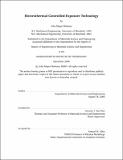Electrothermal controlled-exposure technology
Author(s)
Maloney, John Mapes
DownloadFull printable version (1.644Mb)
Other Contributors
Massachusetts Institute of Technology. Dept. of Materials Science and Engineering.
Advisor
Krystyn J. van Vliet.
Terms of use
Metadata
Show full item recordAbstract
A technology is presented for exposing the contents of microfabricated cavities in a substrate. These contents are hermetically sealed until exposure is triggered by an electronic signal. The exposure mechanism uses electrothermal heating to rupture a metal membrane at one end of the cavity. The device's capability for storing a variety of contents and exposing them on demand makes it well suited for periodic exposure of new sensors as old ones degrade. Two commercialization possibilities are investigated: biowarfare agent detection and in vivo glucose sensing. Both applications employ sensing mechanisms that can be miniaturized and packaged in an array. These sensors are susceptible to fouling or degradation over time from environmental factors. The controlled-exposure technology addresses this problem by periodically exposing fresh sensors. The two applications are thought to be especially favorable markets because of the need for reliable, continuous sensing. The engineering aspects of the technology are investigated by identifying key material properties for each component of the device. (cont.) The key properties for the substrate material are suggested to be its vapor permeability and suitability for cavity formation. The most important properties of the membrane are its electrical requirements (the current and voltage required to expose or "activate" the device), its strength and hermeticity, and its stability in the intended working environment. Design and materials selection approaches for optimizing these properties are presented.
Description
Thesis (M. Eng.)--Massachusetts Institute of Technology, Dept. of Materials Science and Engineering, 2006. This electronic version was submitted by the student author. The certified thesis is available in the Institute Archives and Special Collections. Includes bibliographical references (p. 73-79).
Date issued
2006Department
Massachusetts Institute of Technology. Department of Materials Science and EngineeringPublisher
Massachusetts Institute of Technology
Keywords
Materials Science and Engineering.